If you’re looking for brakes that don’t come from one of the major US or Japanese brands, and have an edgy prototype look, look no further than the brakes from 612. We put them through the wringer for several months to find out whether they’re just for show or if they deliver on the trail.

Never heard of 612? No problem, we’ll tell you all about them. To say that 612 are a small Swiss company would be an exaggeration. Rather, they’re a one-man band, founded and run by Felix, who’s brought a small range of components to the market. In addition to chainrings and derailleur cages for SRAM AXS drivetrains, 612 also offer brakes. Or rather, Die Bremse (The Brake in German). Yes, that is what it’s called. And the brakes look just as simple as their name. They’ve got an angular, industrial look, and you could almost think that they’re still prototypes with their raw, matte finish. Only a small logo on the lid of the brake fluid reservoir reveals the brand name. The four-piston brakes rely on steel braided cables and are manufactured locally: the machined parts, i.e. the brake levers, callipers, master cylinder and reservoir housing are made in Germany. All the parts that are turned, i.e. brake pistons and seals, are manufactured in Switzerland. Felix assembles and ships each brake to order. At 850 CHF (around € 870) per set, they certainly aren’t cheap, but comparing the price to other premium brands like Trickstuff puts things back into perspective. Even the new SRAM CODE Stealth brakes come within this price range. The weight of the front brake including a 90 cm brake hose is 301 g, making it a bit lighter than the competition from SRAM or Shimano, despite the bulky look, though it can’t quite match Trickstuff’s lightweight models.
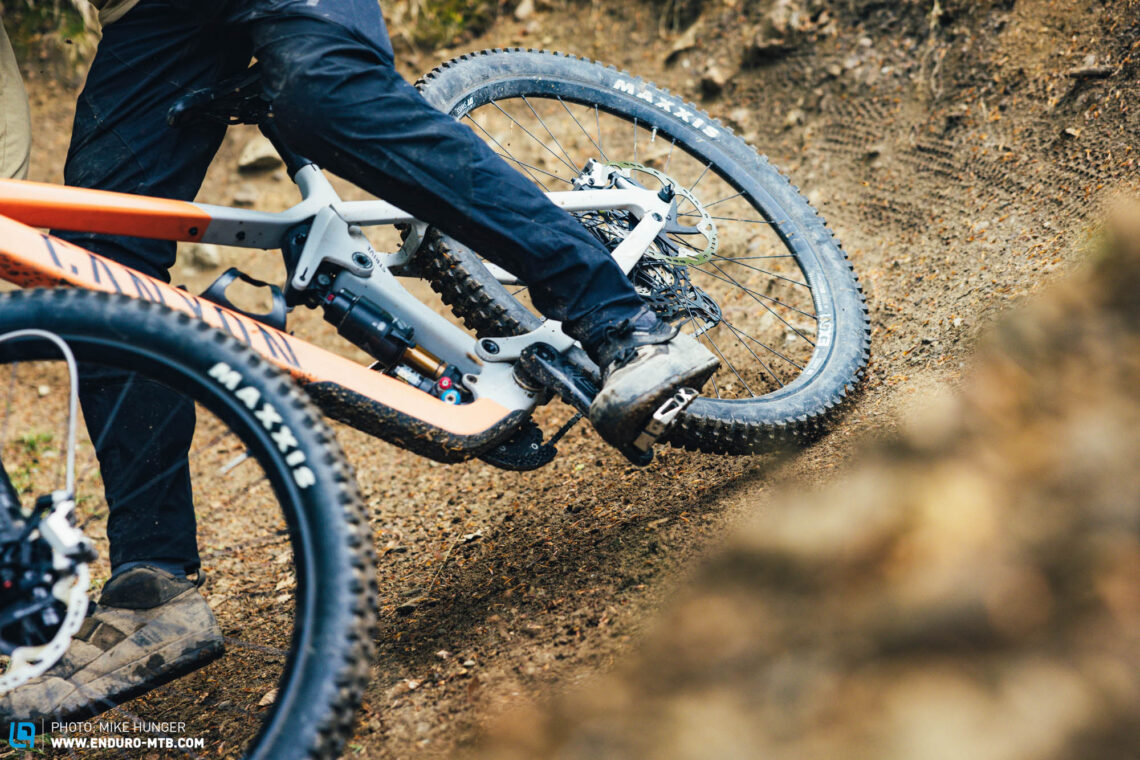
Fitting and setting up the 612 brakes
Fitting the 612 brakes immediately presents a small challenge. Since the steel braided hoses have a diameter of approximately 6 mm (making them about 1 mm thicker than normal brake hoses) you might run into trouble with internal cable routing. As most manufacturers design their bikes to the dimensions of standard brake hoses, you’re particularly likely to have trouble with the routing if it’s guided through channels in the frame. We mounted the brakes to a Canyon Strive, but this only worked after we drilled bigger holes into the cable ports to make room for the thicker steel braided hoses.
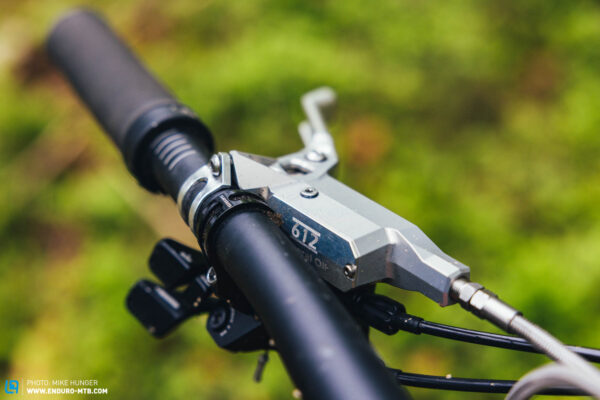

Since you must detach the hoses from the levers when routing them through the frame, it makes sense to bleed the brakes after reconnecting the hoses – despite the fact that the brakes come shipped already bled. To do so, you can use all standard bleed kits with an M5 thread. These include those from Shimano, the old SRAM system (i.e. not Bleeding Edge), and Formula. If you want to perform a complete bleed, it is advisable to bleed the calliper directly with a dismantled hose and an M6 connection and then to press the oil towards the brake lever with the hose mounted and an M5 connection in the banjo bolt. The 612 brakes work with mineral oil, and Felix bleeds them with Bionol before shipping, though all regular mineral oils (e.g. from Shimano or MAGURA) will work. If desired, you can order the brakes with GALFER Pro brake pads, which are the ones Felix recommends, but all pads that have the Hope V4/Trickstuff MAXIMA shape will fit.
Another problem that you might encounter during installation is that the 612 brake lever clamps are incompatible with your shifter. If you’ve been using the SRAM Matchmaker, Shimano I-SPEC, or MAGURA Shiftmix system to attach your shifter to your brakes, you will have to get a separate clamp. In our case, that’s exactly what we had to do since the Shimano XTR trigger was attached to the brake clamp via the I-SPEC standard on our Canyon Strive. However, since the Shimano I-SPEC trigger is shaped differently to their standard triggers, we needed a third-party accessory to clamp it directly to the handlebar. You can get a suitable solution from Wolftooth, but we opted for the hack of combining a MAGURA-SRAM Shiftmix clamp with a standard MAGURA clamp, as we had them lying around. We then attached the trigger with a bolt and nut. It isn’t elegant, but it works. This problem is mainly due to Shimano’s trigger design, but it is annoying, nonetheless.
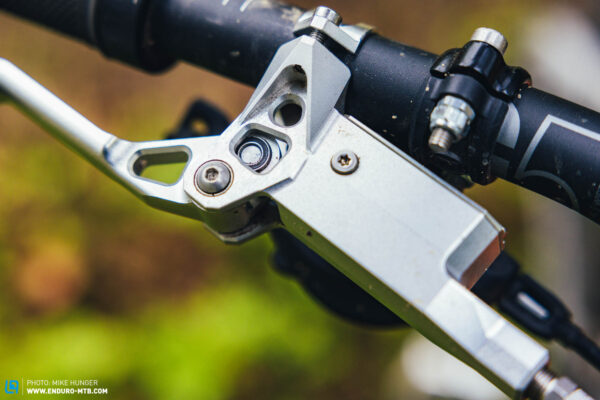

The 612 clamps and bolts are relatively flimsy. As such, the clamp and both bolts bent when we made contact with a tree in a relatively slow and otherwise harmless crash. Considering the bulky prototype styling of the brakes, slightly more robust clamps wouldn’t look out of place. The brake levers, on the other hand, are less prone to damage: the connecting rod that actuates the master cylinder can disconnect, which is intended to prevent the lever from breaking off or even damaging the master cylinder in the event of a crash.
The 612 brake callipers work with all common rotors and are compatible with post-mount adapters from Shimano, MAGURA, and GALFER. You’ll find a list of compatible post mount adapters on the website. We used the brakes with the 203 mm Shimano rotors that were fitted, which worked flawlessly. However, Felix has told us that he’s toying with the idea of also offering his own rotors for Die Bremse.
The lever reach offers a wide range of stepless adjustability, so everyone should find their preferred setting. However, making adjustments requires a 2 mm Allen key. Moreover, the adjusting screw is hard to reach, making the whole process somewhat fiddly. The levers hinge on ball bearings at all pivot points, which promises smooth and frictionless operation.

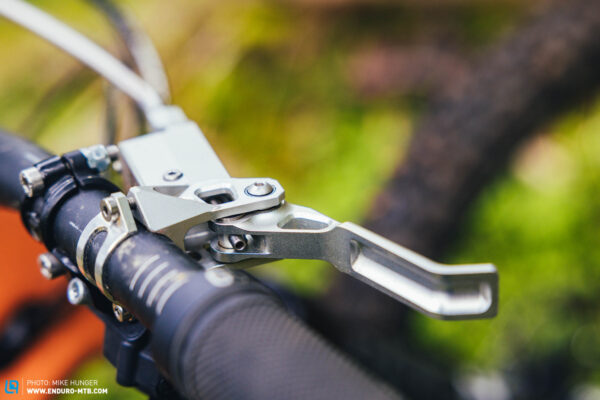
The 612 brakes on the trail
We rode the 612 brakes on the Canyon Strive over the course of several months. This included everything from home trail laps to hard enduro runs and bike park days. And even though we did our best to make the brakes glow red hot, we had no problems with fading brakes no matter how long the descents. Our first impression of the brake levers was that they feel ergonomic and comfortable. They’re relatively wide, comparable to the Hope Tech 4 brakes, but more aggressively curved. You won’t find fluting or other methods of improving grip on the levers of the 612 brakes, but we had no problems with our fingers slipping off.
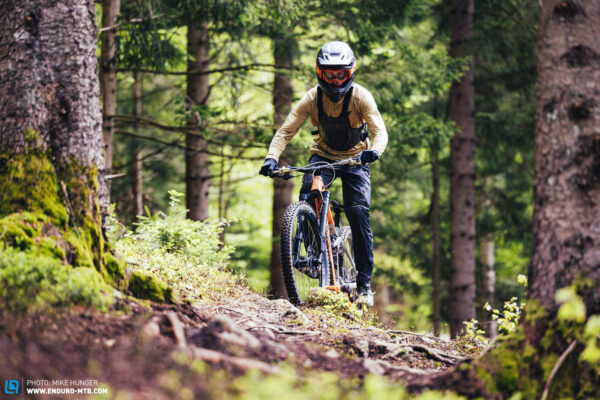
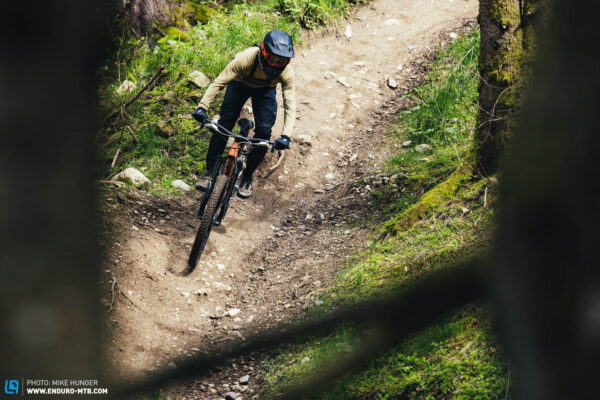
If you test the brake while standing still, they don’t feel particularly crisp at first since there’s a lot of lever throw after you feel the brake pads engage. As such, they don’t have a defined bite point like the Shimano XT. However, once you get going and apply the brakes for the first time, any doubts about braking power will disappear immediately. Here, the 612 brakes offer ample stopping power from the minute they engage, and excellent modulation thanks to the softer lever feel. They don’t take long to get accustomed to and soon disappear from your conscious thoughts and actions. And that’s a good thing, because the 612 brakes perform as they should without you having to think about it. We never experienced wandering bite points or other issues with the brakes throughout the test.

Our conclusion on the 612 brakes
The exclusive 612 brakes stand out from the crowd with their industrial look. They’re locally produced in small batches and give every bike a unique, custom touch. There are a few things to consider when mounting the brakes, but once that is done and you hit the trails, their performance won’t let you down. While not the most affordable, the brakes are a perfectly viable alternative to the common brands, offering ample stopping power and good modulation.
Tops
- powerful
- good modulation
- reliable braking performance
Flops
- difficulties fitting them
- clamps and bolts are undersized
For more information about the brakes, visit 612-parts.com.
Did you enjoy this article? If so, we would be stoked if you decide to support us with a monthly contribution. By becoming a supporter of ENDURO, you will help secure a sustainable future for high-quality mountain bike journalism. Click here to learn more.
Words: Simon Kohler Photos: Mike Hunger









